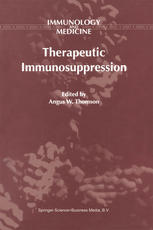Therapeutic immunosuppression has very broad applications in clinical medicine, ranging from prevention and treatment of organ and bone marrow transplant rejection, management of various autoimmune disorders (e.g., rheumatoid arthritis), skin disease, and asthma. Whereas traditionally only a small repertoire of immunosuppressive agents was available for clinical use, recent discoveries have significantly increased the number of approved agents, resulting in numerous trials to further evaluate their potential. In addition, products of the biotechnology industry – monoclonal antibodies, cytokines, cytokine antagonists, and other products of genetic engineering that target key molecular pathways in disease pathogenesis – have either already made, or are on the verge of making an important impact on treatment. There is also considerable interest in the potential of cell-based therapies (particularly hematopoietic stem and dendritic cell therapy) of allo- and autoimmunity. Important recent advances in the immunotherapy of allergic diseases are also covered in this book. Gene therapy offers considerable promise for suppressing pathogenic processes in either transplantation or autoimmune disorders. The possibility of combining these important new advances to maximize benefit to the patient, and to minimize possible untoward effects (which are also given extensive coverage in this book), is one of the most exciting challenges of contemporary medicine.
This volume is intended both for practising physicians and surgeons and for biomedical scientists at the graduate/postdoctoral levels, and is designed to provide the theory behind these various approaches to immunosuppression, and to provide state-of-the-art reviews of current developments in each area. Each chapter is contributed by one or more experts in the field. There was a need to bring this information together in a single volume, as much of the key recent developments have been dispersed throughout the biomedical literature, largely in specialized journals. Since, as in the past, important developments in immunosuppressive therapy in one branch of medicine (i.e. transplantation) are likely to benefit another (e.g., dermatology, rheumatology, gastroenterology), cross-disciplinary coverage of the mechanistic basis of the various therapeutic strategies in a single volume is likely to convey the potential of advances in therapy in the most coherent manner possible.
Medicine
[PDF] Therapeutic Immunosuppression Lina Kung, Philip F. Halloran (auth.), Angus W. Thomson (eds.)
$9.99






Reviews
There are no reviews yet.